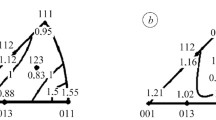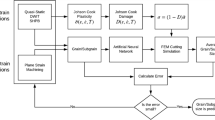Abstract
The back-propagation neural (BPN) network was proposed to model the relationship between the parameters of the dieless drawing process and the microstructures of the QSi3-1 silicon bronze alloy. Combined with image processing techniques, grain sizes and grain-boundary morphologies were respectively determined by the quantitative metallographic method and the fractal theory. The outcomes obtained show that the deformed microstructures exhibit typical fractal features, and the boundaries can be characterized quantitatively by fractal dimensions. With the temperature of 600–800°C and the drawing speed of 0.67–1.00 mm·s−1, either a lower temperature or a higher speed will cause a smaller grain size together with an elevated fractal dimension. The developed model can be capable for forecasting the microstructure evolution with a minimum error. The average relative errors between the predicted results and the experimental values of grain size and fractal dimension are 3.9% and 0.9%, respectively.
Similar content being viewed by others
References
T. Watanabe and S. Tsurekawa, Toughening of brittle materials by grain boundary engineering, Mater. Sci. Eng. A, 387–389(2004), p.447.
V. Randle, Twinning-related grain boundary engineering, Acta Mater., 52(2004), No.14, p.4067.
H. Ahmed, M.A. Wells, D.M. Maijer, et al., Modelling of microstructure evolution during hot rolling of AA5083 using an internal state variable approach integrated into an FE model, Mater. Sci. Eng. A, 390(2005), No.1–2, p.278.
R. Colás, On the variation of grain size and fractal dimension in an austenitic stainless steel, Mater. Charact., 46(2001), No.5, p.353.
J. Zhang, H. Su, B. Tang, et al., Fractal characteristic of laser zone remelted Al2O3/YAG eutectic in situ composite, J. Cryst. Growth, 310(2008), No.2, p.490.
M. Takahashi, H. Nagahama, T. Masuda, et al., Fractal analysis of experimentally, dynamically recrystallized quartz grains and its possible application as a strain rate meter, J. Struct. Geol., 20(1998), p.269.
N. Afrin, D.L. Chen, X. Cao, et al., Microstructure and tensile properties of friction stir welded AZ31B magnesium al loy, Mater. Sci. Eng. A, 472(2008), No.1–2, p.179.
P. Streitenberger, D. Förster, G. Kolbe, et al., The fractal geometry of grain boundaries in deformed and recovered zinc, Scripta Metall. Mater., 33(1995), No.4, p.541.
R. Kapoor, D. Pal, and J.K. Chakravartty, Use of artificial neural networks to predict the deformation behavior of Zr-2.5Nb-0.5Cu, J. Mater. Process. Technol., 169(2005), No.2, p.199.
G. Costanza, M.E. Tata, and N. Ucciardello, Superplasticity in PbSn60: Experimental and neural network implementation, Comput. Mater. Sci., 37(2006), No.3, p.226.
N.S. Reddy, Y.H. Lee, C.H. Park, et al., Prediction of flow stress in Ti-6Al-4V alloy with an equiaxed α+β microstructure by artificial neural networks, Mater. Sci. Eng. A, 492(2008), No.1–2, p.276.
J. Ai, J. Xu, H. Gao, et al., Artificial neural network prediction of the microstructure of 60Si2MnA rod based on its controlled rolling and cooling process parameters, Mater. Sci. Eng. A, 344(2003), No.1–2, p.318.
W. Tan, Z.Y. Liu, D. Wu, et al., Artificial neural network modeling of microstructure during C-Mn and HSLA plate rolling, J. Iron Steel Res. Int., 16(2009), No.2, p.80.
J. Kusiak and R. Kuziak, Modelling of microstructure and mechanical properties of steel using the artificial neural network, J. Mater. Process. Technol., 127(2002), No.1, p.115.
Y. Kawaguchi, K. Katsube, M. Murahashi, et al., Applications of dieless drawing to Ti-Ni wire drawing and tapered steel wire manufacturing, Wire J. Int., 24(1991), p.53.
P.V. Kuznetsov, V.E. Panin, and J. Schreiber, Fractal dimension as a characteristic of deformation stages of austenite stainless steel under tensile load, Theor. Appl. Fract. Mech., 35(2001), No.2, p.171.
Author information
Authors and Affiliations
Corresponding author
Additional information
This work was financially supported by the National Basic Research Priorities Program of China (No.2006CB605200), the National Natural Science Foundation of China (Nos.50674008 and 50634010), the Program for New Century Excellent Talents in Chinese Universities (No.NCET-06-0083), and the Foundation of State Key Laboratory for Advanced Metals and Materials (No.2008Z-15)
Rights and permissions
About this article
Cite this article
Wang, Z., Liu, Xf., He, Y. et al. A fractal-based model for the microstructure evolution of silicon bronze wires fabricated by dieless drawing. Int J Miner Metall Mater 17, 770–776 (2010). https://doi.org/10.1007/s12613-010-0387-4
Received:
Revised:
Accepted:
Published:
Issue Date:
DOI: https://doi.org/10.1007/s12613-010-0387-4




